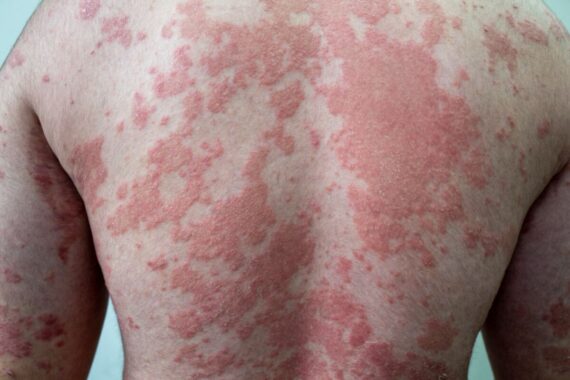
In the latest in our series from Pulse Live talks, GpwER in dermatology Dr Anna Trigell offers her top tips for diagnosing and managing psoriasis in general practice
Psoriasis is a debilitating chronic condition that affects sufferers on a daily basis. They struggle with the clothes they can wear, they are self-conscious about swimming, exercising or getting their hair cut and embarrassed when starting new relationships.
In primary care, our role is to empathise with these daily problems, to enable and empower the patient to manage their condition and refer on when needed.
1. Confirm the diagnosis
Common differentials include discoid eczema, tinea and intertrigo. It is important to look for all the clues to differentiate these conditions.
Psoriasis tends to be symmetrical, with common sites including the scalp, ears, umbilicus, elbows, natal cleft and knees. Other areas can also be affected but there is likely to be involvement of at least one or two of these classic sites.
The nails provide an important clue to diagnosis. Signs range from small pits in the nails and/or yellowish ‘oil spot’ patches through to onycholysis (lifting of the nail bed) and occasionally very destructive changes.
Family history can provide another supporting factor, with many patients having at least one relative with psoriasis.
2. Ask specifically about all the areas that might be affected including natal cleft and genitals
Patients don’t always volunteer this information so always ask about these areas.
It is also worth asking which area affects the patient the most. For example, some patients are covered in large plaques over their torso but is the milder scale of the scalp or the visible patches on their hands which affects them day to day. It is then possible to concentrate on these areas initially.
Psoriasis is a chronic disease and it is often unrealistic to achieve control and plan maintenance of all areas in a single appointment. We wouldn’t expect to achieve this with diabetes and it is sometimes helpful to think of psoriasis in a similar way and plan regular reviews to assess and monitor treatments.
3. Prescribe suitable quantities of emollients and add them to their repeats
Explain to patients that psoriasis is a dry skin condition. This means they should use soap substitutes or sensitive skin washes and daily emollients. Doctors prefer greasy emollients, patients don’t always. The best one is the one the patient will use. Remember lotions and creams are lighter and more water based, ointments are greasier and oil based, and gels sit in the middle.
Please prescribe enough and add it to their repeats. There is pressure not to prescribe emollients, but if there is a diagnosed dermatological condition such as eczema or psoriasis, NICE guidance encourages prescribing of ‘generous’ amounts of these as it is essential to management.
4. Prescribe active treatments according to body site and add to their repeats
Active treatments regimes are based on body site. I break it up into two main groups – torso/ limbs and sensitive areas (flexures, genitals and face).
The first group is treated with a combination product of vitamin D analogue and betamethasone (dovobet ointment, dovobet gel, enstilar foam, wynzora cream). This differs slightly from NICE guidance but in view of practicality and effectiveness is widely accepted practice.
The second group of more sensitive areas are treated with split products of steroid alone (hydrocortisone or eumovate) plus a more gentle vitamin D analogue (Silkis or Curatoderm) as calcipotriol based products can be irritant in these areas.
Patients should use the active treatment daily for 4-8 weeks until clearance has occurred then arrange review to assess effectiveness and reduce to a maintenance regime. The licenses differ slightly for each of the products for maintenance treatment. In practice, it is acceptable long term use if they are using appropriate strength topical steroid for less than half the time on affected areas.
Please allow the patient to manage their condition by adding their treatment to their repeats. Psoriasis is a chronic condition and they are going to need it ongoing. Document clearly on the prescription where it is to be used and how often, both for flare ups and maintenance.
5. Management of other ‘special sites’
Scalp psoriasis can be managed with a tar-based shampoo plus sebco or cocois ointment if there is significant scale, with topical steroid (diprosalic, betacap) or a combination product (dovobet gel, wynzora cream). As before, gain control then advise on a maintenance regime.
Hands and feet are stubborn areas and will need urea based emollients and potent or very potent topical steroid. Fludroxycortide tape is very good overnight for splits and cracks in fingers and toes. If you aren’t winning, refer on early as these are very debilitating sites.
Nails are tricky! Advise the patient to keep nails short and avoid prosthetic nails or manicures (increases the risk of paronychia). Nail varnish is acceptable but use gentle removers. Dovobet gel massaged around the nail for three months can be tried and consider referral to secondary care if they are causing significant distress, but the options are limited.
6. When to refer
In general, consider early referral for your patients if the diagnosis is unclear, more than 30% of their body area is affected, the topical treatments aren’t working or there is significant impact on their quality of life.
7. Holistic care of the patient with psoriasis
Psoriasis is an inflammatory condition and insults that increase inflammatory cytokines in the body can either exacerbate it or make it harder to treat. We should be encouraging our patients to stop smoking, lose weight, reduce their alcohol intake and minimise their stresses. Screen for and manage any associated depression or anxiety. Sleep is becoming increasingly recognised as an important part of patient wellbeing and long term health and it is worth addressing this if needed.
We should also try to ensure we are speaking to our patients at least annually for a review. Does anything need changing or escalating? Have they been started on any new meds that may inadvertently be exacerbating their psoriasis? The commonest ones are beta-blockers, lithium, anti-malarials and NSAIDs.
Screen them for CVD at least every 5 years and discuss risk factors for this. Think about psoriatic arthritis, especially if their nails are affected. There is an easily available screening tool called the PEST score which can be found online, to ensure early rheumatological intervention.
In summary, confirm that you are happy with psoriasis as a diagnosis. Develop a simple treatment regime with the patient based on the location on the body. Discuss health improvements and explain why they are needed. Review after a month or so to assess improvements or barriers to treatments and to step down to a maintenance program, and review annually to manage risk factors, monitor treatment and escalate care if needed.
Dr Anna Trigell is a GPwER in dermatology at Buckden Community Dermatology Service and a prison GP at HMP Littlehey

















